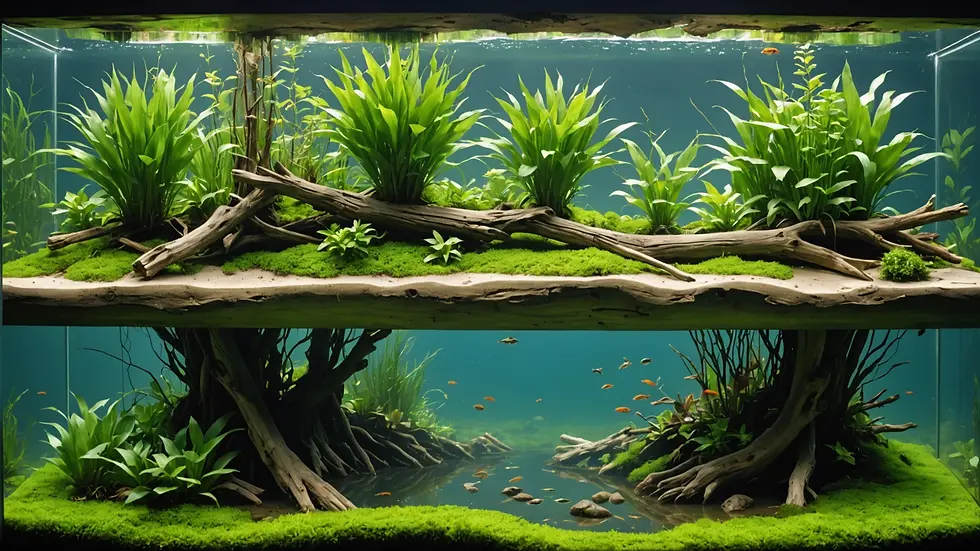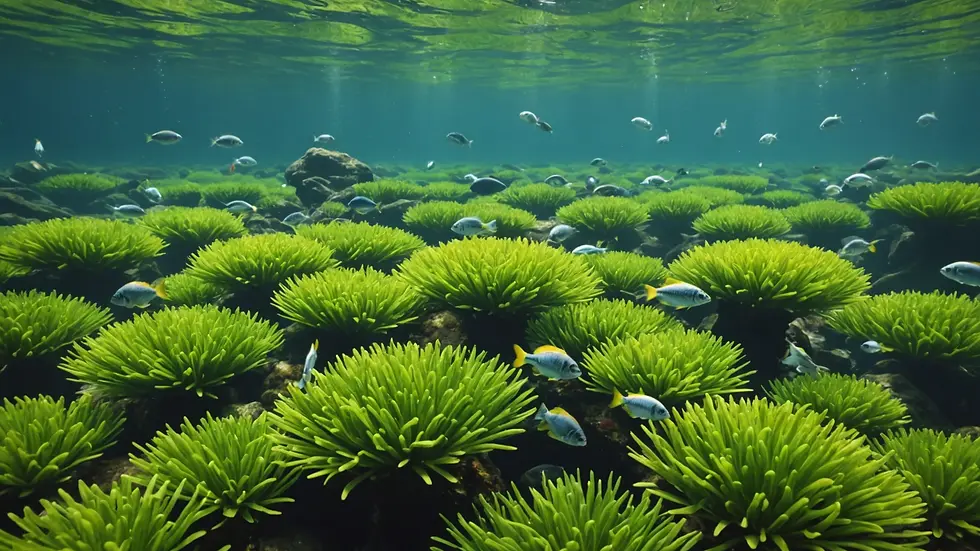Exploring the Essentials of a Brackish Water Tank Setup: An Uncharted Journey
- Jyotiraj Borah
- Feb 8
- 4 min read
Creating a brackish water tank is an exciting adventure for aquarists who want to explore unique aquatic environments. Brackish water ecosystems, which are somewhere between freshwater and saltwater, offer a fascinating array of species. This post will guide you through the essentials of setting up a brackish water tank. You will learn about the necessary components, suitable species, and maintenance tips to ensure your success.
Understanding Brackish Water
Brackish water is a blend of freshwater and saltwater, typically found in locations like estuaries. Its salinity usually ranges from 1.005 to 1.025 specific gravity. This environment supports a distinctive range of flora and fauna. For example, certain fish, such as the Atlantic mudskipper, thrive in these waters and display unique behaviors not seen in purely freshwater or saltwater species.
Brackish water tanks can showcase a captivating mix of species, offering a colorful display. Research shows that having a diverse tank can also lead to better health for the fish, as species coexist and interact more naturally.
Key Components of a Brackish Water Tank Setup
Setting up a brackish water tank requires careful consideration of several key components. Their proper selection will foster a healthy environment for aquatic life.
Choosing the Right Tank Size
When choosing a tank, remember that size matters. A tank of at least 30 gallons allows for greater stability and can accommodate a wider variety of species. Larger tanks reduce fluctuations in water parameters, leading to happier, healthier fish. For instance, a 55-gallon tank can house more fish without overcrowding, benefitting species such as green chromis or bumblebee gobies.
Water Conditioning and Salinity
Achieving the appropriate salinity is critical. Many aquarists use artificial marine salts mixed with dechlorinated water to reach the correct levels. Using a hydrometer can help keep consistent salinity. For example, maintaining a specific gravity around 1.010 is suitable for many popular species.
Filtration System
Invest in a solid filtration system to ensure water quality. A canister filter with both mechanical and biological filtration capabilities is ideal. For instance, a filter rated for a 50-gallon tank can effectively handle water changes, keeping it clean and safe.
Substrate Selection
The substrate impacts the aesthetics and health of your tank. Fine sand is often recommended because it mimics natural brackish environments. It supports beneficial bacteria that improve biological filtration. Adding a depth of about 2-3 inches allows for natural burrowing, which many species appreciate.
Aquascaping
Creating a natural habitat with rocks, driftwood, and live plants enriches your brackish tank. Driftwood and rocks provide hiding spots, encouraging natural behaviors in your fish. Choose plants carefully, as not all freshwater species can thrive in brackish conditions. Suitable options include seagrasses and mangroves, adding richness and stability to your setup.

Heater and Lighting
A quality heater is necessary to maintain stable temperatures between 75°F to 80°F. LED lights are recommended for their energy efficiency and ability to simulate natural sunlight. These lights will help support plant growth while enhancing the tank's visual appeal.
Selecting Suitable Species
Choosing compatible inhabitants for your brackish water tank is crucial for a balanced ecosystem. Explore these popular options:
Brackish Water Fish
Green Chromis – Hardy and peaceful, these vibrant fish add color and are ideal for community tanks.
Bumblebee Goby – Known for their striking appearance, bumblebee gobies prefer sandy substrates and are highly engaging.
Mullet – Tolerant of various salinities, mullets exhibit natural foraging behaviors, providing a lively addition to your aquarium.
Invertebrates
Brine Shrimp – They not only serve as food for fish but also thrive in brackish settings.
Ghost Shrimp – Their scavenging habits help in maintaining tank cleanliness.
Saltwater Snails – Certain saltwater snail species can tolerate brackish conditions, offering aesthetic benefits.
Plants
Java Fern – Adaptable and easy to care for, this plant provides shelter and oxygenation while thriving in brackish water.
Seagrasses – Some varieties help stabilize substrates and create habitats.
Mangroves – Introducing mangrove plants can enhance your tank's biotope, providing a natural feel.
Cycling Your Brackish Water Tank
Before adding any fish or invertebrates, properly cycling your tank is essential. This process establishes beneficial bacteria that break down harmful ammonia and nitrites.
How to Cycle Your Tank
Fishless Cycling: Use pure ammonia drops to introduce ammonia to the tank without fish. Bacteria will develop and process this ammonia into nitrates.
Using Live Bacteria: Purchase live nitrifying bacteria to expedite the cycling process. Check the instructions from your supplier for effective use.
Testing Water Parameters: Regularly test the water for ammonia, nitrites, and nitrates. Aim for zero ammonia and nitrites, with nitrates gradually increasing.

Maintenance Practices
Once your tank is set up and inhabited, think about regular upkeep. Consistent maintenance helps keep your aquarium thriving.
Water Changes
Do regular partial water changes (10-20% weekly) to dilute harmful substances and restore vital minerals. Use dechlorinated water mixed to the correct salinity to avoid stressing your fish.
Monitoring Parameters
Continuously test water parameters, including pH, salinity, ammonia, nitrites, nitrates, and temperature. Maintaining ideal ranges guarantees a healthy tank.
Cleaning the Tank
Keep the tank clean by regularly maintaining the substrate and decorations. However, be cautious not to disturb beneficial bacteria. Use a gravel vacuum during water changes to remove waste without disrupting the ecosystem.
Troubleshooting Common Issues
Even with the best setup, issues can arise in your brackish water tank. Here are some common problems and solutions:
Algae Bloom
Excessive algae can result from overfeeding or too much light. Reduce feedings and adjust the lighting as needed to control algae growth.
Unexplained Fish Deaths
If fish begin dying unexpectedly, test the water immediately for ammonia or nitrite spikes. Making a partial water change can often remedy the situation.
Stress Among Fish
Watch for signs of stress, such as hiding or aggression. Verify that tank mates are compatible and that there are ample hiding spots available.
The Journey Ahead
Setting up a brackish water tank can provide a fulfilling experience. It allows aquarists to explore a unique aquatic ecosystem. From understanding the essential components for a successful setup to selecting diverse species and conducting regular maintenance, your journey can be both educational and enjoyable.
With thoughtful planning and execution, your brackish water tank can thrive, becoming a beautiful feature in your home. Gather your supplies, choose your species wisely, and embark on this exciting aquarium adventure.





Comments